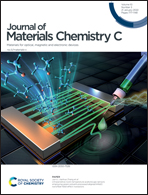Reactive phosphine combinatorial co-sputtering of cation disordered ZnGeP2 films†
Abstract
The discovery of new materials by coupling high-throughput synthesis with computational screening is being increasingly adopted. However, thus far, phosphides have been largely overlooked for both computational screening and high-throughput synthesis. In this paper, we report on the use of a high-throughput synthesis technique, reactive combinatorial co-sputtering with PH3, to deposit ZnGeP2 thin films. We grew amorphous films over a wide range of compositions and found an upper limit in growth temperature determined by Zn and P volatility. We found that depositing in a Ge-limited regime could be utilized to slow the growth rate to compensate for the desorption of the Zn and P. Crystalline films were achieved by depositing films at higher temperatures in this Ge-limited regime with a reduced deposition rate. X-ray diffraction revealed that the films had crystallized in the zinc blende, cation-disordered structure. The crystalline films exhibited optical absorption energy threshold values ranging from 0.8 to 1.3 eV. Increased Ge content was found in films that exhibited a decreased absorption onset energy. Native defect calculations were used to gain an understanding of the off-stoichiometry seen in these films. This work provides the first high-throughput investigation of ZnGeP2, demonstrating the ability to grow amorphous and cation disordered ZnGeP2 over a wide range of compositions with varying optical properties.



 Please wait while we load your content...
Please wait while we load your content...